It is always a joy as a collector when you stumble over an item related to your collections which you know existed because you have read about it or seen a photograph but which you had never seen before. This has just happened to me with the Draw-Bridge Travellers’ Model from Goodall & Son which I describe below. This got me thinking about all the other items related to Draw-Bridge and Double Dummy games which I have accumulated over the years, some of which I have written about elsewhere.¹
My good friend, the late Julian Laderman, was not a fan of two-handed bridge. In 2017 he wrote “With two bridge players, my advice is to play chess, or a card game designed for two players, or to watch a movie or any other activity appropriate for two consenting adults. It is best to avoid playing two-person bridge”. And later “ In summary, before getting into the habit of playing any two-player form of bridge, I recommend that you and your playmate should try to be a little nicer and thereby make two new friends so that you can play the four-person form”.²
Nevertheless, in the early years of the 20th century several firms began to promote two-handed whist or bridge as an alternative game for two. In 1906, Goodall & Son published the mini-book “Draw-Bridge” by Charles W. Diehl to accompany various boxed sets as these contemporary adverts show.
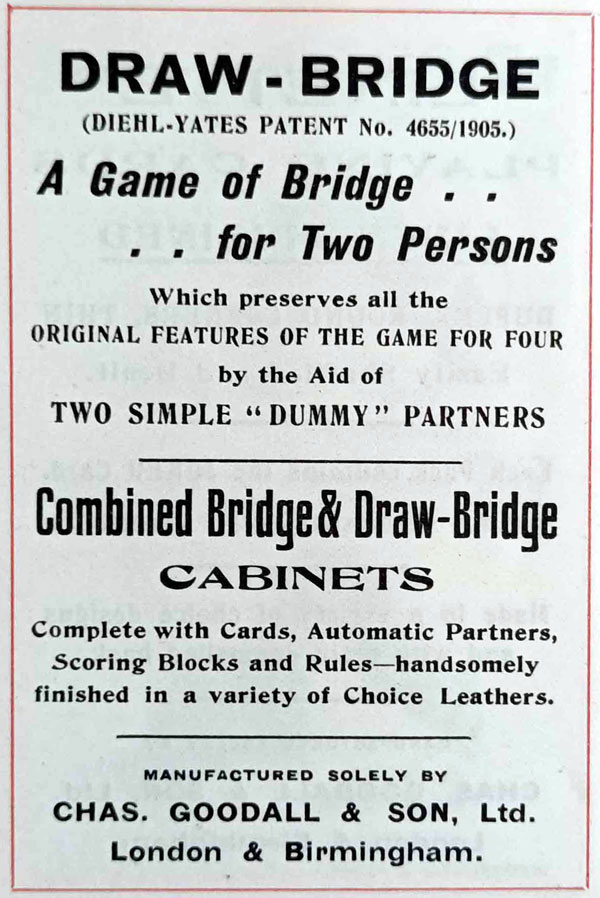

These two adverts from 1909 and 1910 respectively advertised three different styles of Goodall sets. The first is illustrated in the ad (numbered 10382) but as yet I have not found a set of this kind (or even a photograph) to include here. It appears to comprise two wooden card-holding boards on two very distinct tiers with the upper tier looking rather tall and ornate. I will keep looking!
The second, the Compact Model, no.10474, is far more familiar and I have several versions. It contains two wooden bases in different woods – one for each player – designed to hold a hand of standard sized playing cards. Although each is designed for two rows of cards, one higher than the other, the higher tier appears far less elevated and elaborate than in the first set.
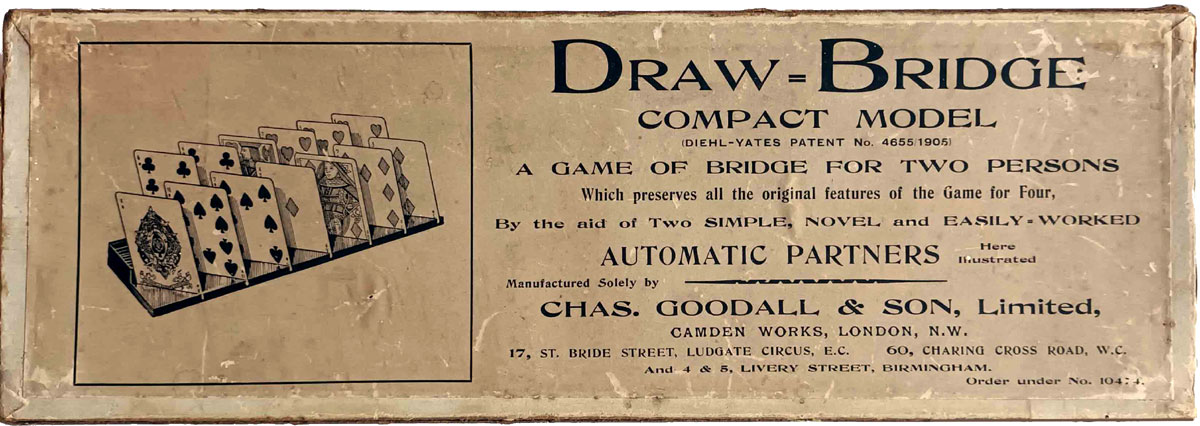

And finally, the much more expensive combined “Bridge and Draw-Bridge” set containing the Diehl booklet dated 1909, the same year as the advertisement. This box contains, not only two instruction booklets – for Bridge and Draw-Bridge – but the two wooden Draw-Bridge cardholders, two packs of cards, and two “Acme” Bridge scoring tablets, complete with metal-crowned pencils. The scoring tablets show the scoring system then current and used for bridge-whist (see below|)
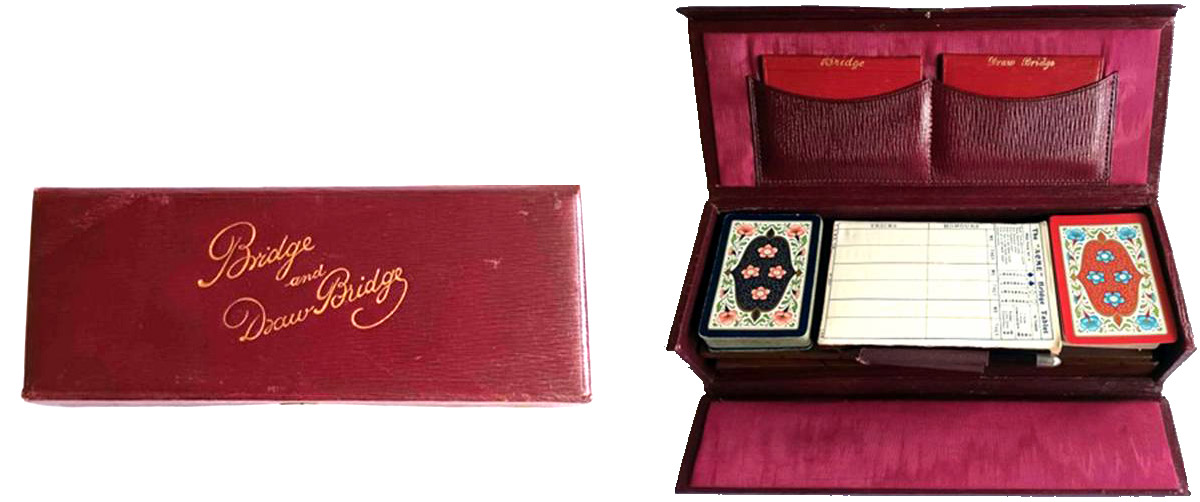
My new acquisition is not included in this advert as it was introduced later. The Travellers’ Model (Order no. 1321 Draw Bridge – travellers’ model) was designed for use with Patience Size Playing Cards. Mike Goodall’s “catalogue” of Goodall & Son cards and accessories³ contains a single uninformative line under the heading “Card Holders”, amongst a variety of more familiar models.
And here it is:
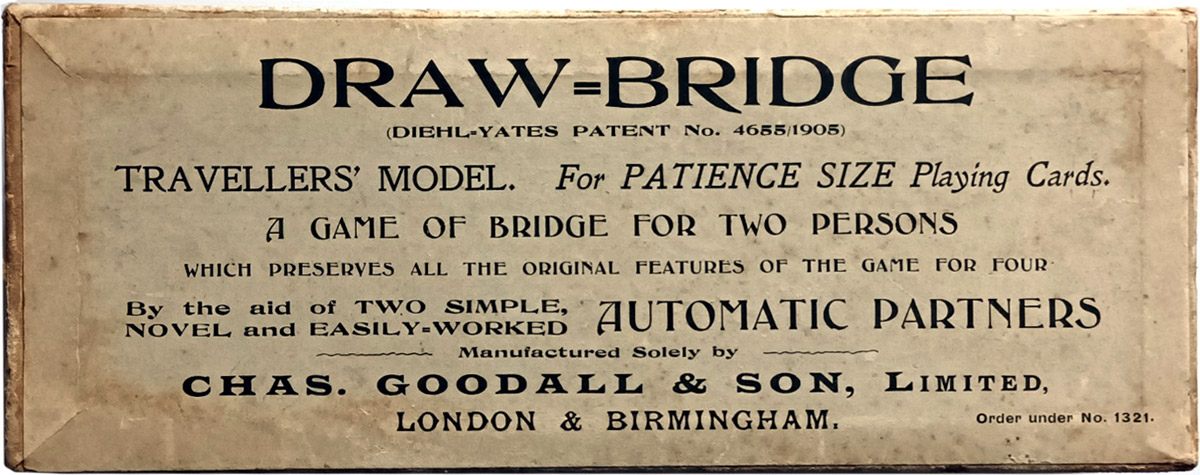
The original Diehl instruction booklet contained in the box is dated February, 1914 and is unchanged from earlier editions. It describes Draw-Bridge as “A Game of Bridge for two Persons which preserves all the original features of the game of four by the aid of two simple ‘Dummy’ partners’. Interestingly, an advert in the booklet refers to another model called “Royal Auction Draw-Bridge which underlines the evolving nature of the game at this point, just before WW1. Whereas the “Compact “ board was 27.5 x 9,1 cm, the Travellers’ version is 17.8 x 6.3 cm; considerably smaller as shown below, although the depth of both was the same at 2.3 cm.
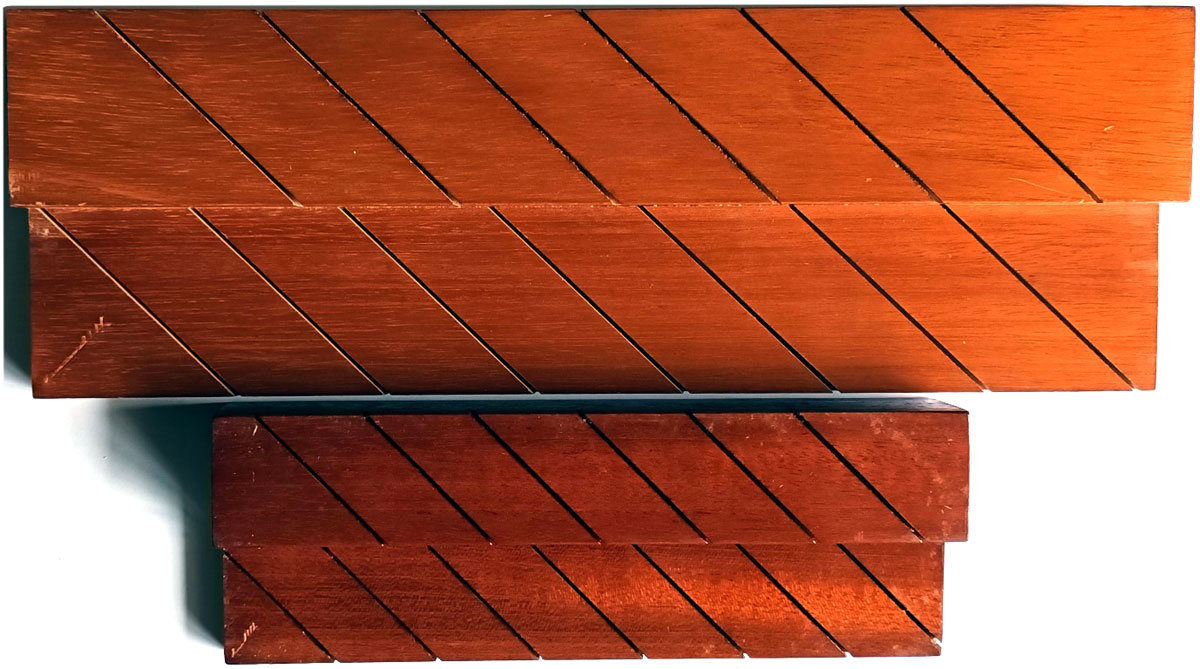
Chad Valley also entered the market with an entirely different design of board.

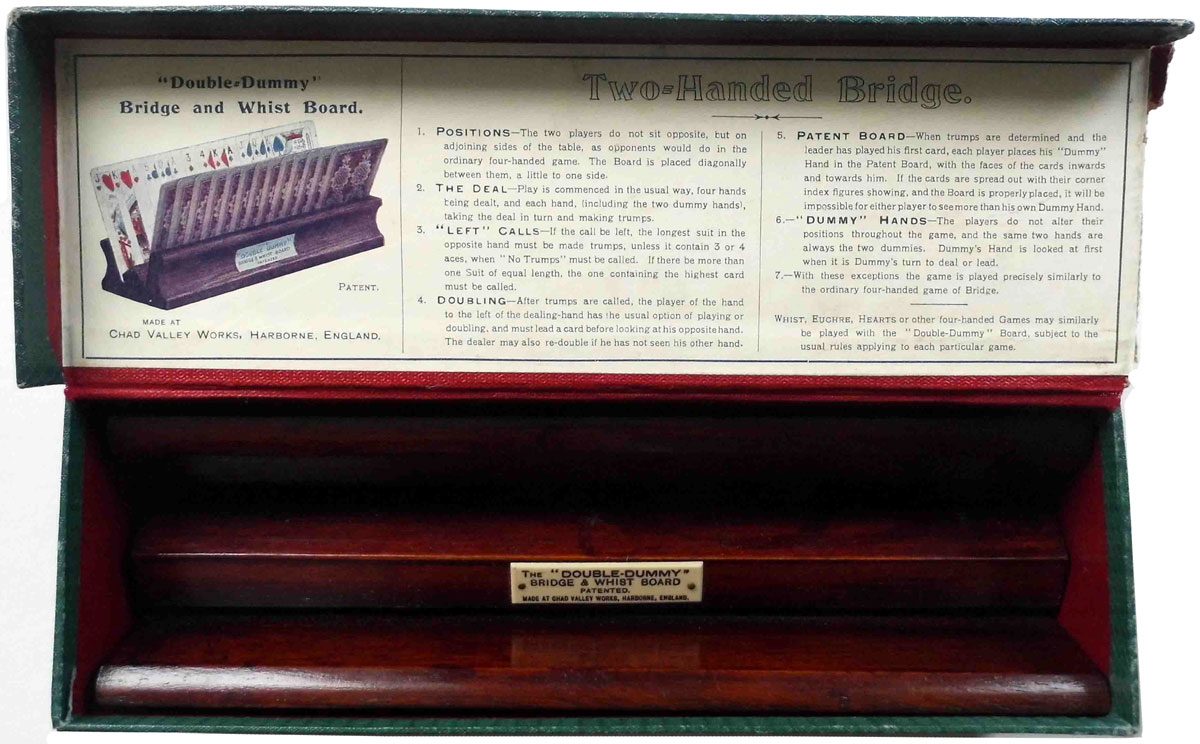
The Chad Valley board is beautifully constructed from three pieces of mahogany glued together and highly polished. My example shows no sign of wear after more than a century which suggests, maybe, that it wasn’t much used. The board is designed to carry two 13 card hands positioned in such a way that each player can see their own “dummy partner’s” hand but not that of their opponent. I will confess at this point to disbelief that this could ever work, but amazingly it does and is extremely easy to use.
Far less beautiful, and yet another different design, is my final example. It does not, sadly, identify a manufacturer but it is unlikely to have come from either Goodall & Son or Chad Valley. Could this possibly be from their prime competitor at this point, De La Rue? I can find no evidence of DLR entering this market in any other way.

Inside this slim box, measuring 27.7 x 6.3 x 2.8 cm, are two enamelled cardboard holders with a ledge at the base capable of holding full-size playing cards.


Each card holder contains a hinged back limited by a short strip of fabric and secured by a triangle at one end which flaps into place to keep the holder rigid when in use. Quite ingenious and far more practical as a travel accessory than the Goodall and Son Travellers’ version.

Any information about this, or any other Double Dummy productions, would be most welcome.
It is worth pointing out that while the game of four-handed bridge was evolving at this time in stages from whist, through bridge-whist and auction bridge to the modern form of contract bridge, the rules of play for “Draw-bridge” (or “double dummy” bridge) were devised before 1905 and were based on a scoring system at the earliest stage of this evolution, namely bridge-whist as it came to be called. However, by today’s standard of scoring in contract bridge, this early form of the game seems somewhat bizarre. As now, a rubber comprised the best of three games. A game was achieved by scoring 30 points. Each trick (above 6) was scored according to this scale: 2 points per trick when spades are trumps; 4 for clubs, 6 for diamonds, 8 for hearts and 12 for no trumps. Thus, a total of 9 tricks in no trumps achieved game i.e. 6 + 3 (@ 12 per trick) = 36. Four hearts also achieved game. But if a partnership managed to win all 13 tricks (i.e. a grand slam in modern parlance) in either clubs or spades they would fail to achieve even a game score (28 and 14 respectively) and there were no bonuses for achieving either slam which must have proved very frustrating. Little wonder that this form of scoring didn’t last long until it was replaced with auction bridge, the next step in the evolutionary process.
Against this background, the process of bidding in Draw-Bridge involved the two players looking at their hands and, if possible, making a bid before the dummy hands were displayed. Bids would propose particular suits for trumps,(following the spades, clubs, diamonds, hearts, no trumps hierarchy) and could be doubled and redoubled as suggested by the cards held. If no bid was forthcoming from the live players, the dummy hands were revealed and bids made on behalf of the dummy hands in accordance with a set of rules e.g. If the hand contains 3 or 4 aces the call is “no trumps”; otherwise, the longest suit is declared as trumps; if suits are of equal length, the strongest suit is called. etc etc. There appears to be no adjustment in the bidding to take account of a possible fit between the dummy and the player’s hand. The rules specify the suit to be declared as trumps, or no trumps, but make no reference to the number of tricks bid in that suit. Hence players are not bidding for a specific contract (i.e say 3 hearts or 4 diamonds) but will simply score any tricks won by the successful bidding partnership over six when their specified suit is trumps, or when the hand was played in no trumps.
Collaborators C.V. Diehl and J.W. Yates patented this form of game in March 1905, although it is far from clear whether the patent simply covers the design of the card holders, or the rules of play, or both. The rules of play for Goodall’s Draw-bridge game (recognising the Deihl-Yates patent) appear to be exactly the same as those reproduced in the lid of the Chad Valley game where no mention is made of Deihl and Yates, and their elaborate cardholder is itself subject to a separate patent.
Tony Hall, 27 May 2025
References
- Why do we collect? My 20 Favourite items, wopc, 2020. Card Game Items and Contemporary advertisements, wopc, August 2023
- Julian Laderman, Play Bumblepuppy Bridge, Master Point Press, 2017
- M.H.Goodall, “The Family and the Firm 1822 – 1922”, M.H.G, 2000